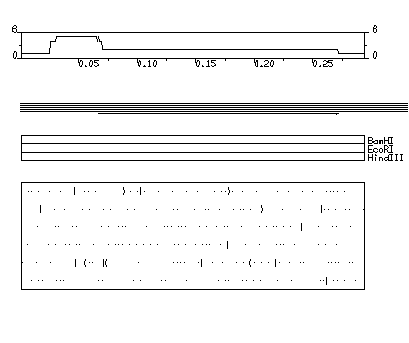Gelfigure
GELFIGURE(+)
FUNCTION
GelFigure produces a graphical report of the status of a contig in a fragment assembly project.
DESCRIPTION
GelFigure produces a graphical summary of a contig in a fragment assembly project. The output is in four sections: a redundancy plot, a diagram of the directoions and orientations of sequence fragments, a restriction map and a plot of open reading frames.
The plot is intended both as a quality guide during the course of a sequencing project, and as a final report for a completed assembly.
AUTHOR
This program was written by Peter Rice (E-mail: pmr@sanger.ac.uk Post: Informatics Division, The Sanger Centre, Hinxton Hall, Cambridge, CB10 1RQ, UK).
All EGCG programs are supported by the EGCG Support Team, who can be contacted by E-mail (egcg@embnet.org).
EXAMPLE
Here is a sample session with GelFigure
% gelfigure -MINframe=50
GelFigure of which contig? Mu27
What codon frequency file (* ecohigh.cod *) ?
What enzyme file (* gelenzyme.dat *) ?
Contig length: 294
No. of fragments: 6
Max. redundancy: 5
Max. arrow depth: 20
Restriction enzymes: 3
Restriction sites mapped: 0
1: BamHI , 0 cuts
2: EcoRI , 0 cuts
3: HindIII , 0 cuts
%
OUTPUT

This is the plot from the example session
INPUT FILE
The input file for GelFigure is a contig in a GCG fragment assembly project.
COMMAND-LINE SUMMARY
All parameters for this program may be put on the command line. Use the option -CHEck to see the summary below and to have a chance to add things to the command line before the program executes. In the summary below, the capitalized letters in the qualifier names are the letters that you must type in order to use the parameter. Square brackets ([ and ]) enclose qualifiers or parameter values that are optional. For more information, see "Using Program Parameters" in Chapter 3, Basic Concepts: Using Programs in the GCG User's Guide.
Minimum Syntax: % gelfigure [-CONtig=]mu27 -Default Required Parameters: -INfile1=ecohigh.cod Codon frequencies for open reading frames plot -ENZymes=gelenzyme.dat Enzymes selected for restriction map Optional Parameters: -ARROWs=20 Maximum redundancy (number of arrow rows on plot) -AHeight=1.0 Height of arrowhead in platen units -HEAD=20.0 Length of arrowhead in bases -SEParate=10 Minimum gap between arrows (bases) -MINframe=100 Minimum open reading frame length (residues) -THReshold=0.1 Threshold value for plotting rare codons Local Data Files None
LOCAL DATA FILES
The files described below supply auxiliary data to this program. The program automatically reads them from a public data directory unless you either 1) have a data file with exactly the same name in your current working directory; or 2) name a file on the command line with an expression like -DATa1=myfile.dat. For more information see Chapter 4, Using Data Files in the User's Guide.
GelFigure uses two local data files to define the restriction enzymes used in the map, and the codon frequencies used in the open reading frames plot.
See the Data Files volume of the Data Reference Set for a listing of the codon frequency tables currently provided with the GCG Package. See the CodonFrequency program in the GCG package for instructions on building a codon frequency table for other organisms.
You can provide the codon table on the command line with an expression like -FREQuency=tablename.cod .
You can provide the enzyme file on the command line with an expression like -ENZymes=enzyme.select . or create a file with the default name of gelenzyme.dat. The MapSelect program is the easiest way to create a small enzyme file.
OPTIONAL PARAMETERS
The parameters and switches listed below can be set from the command line. For more information, see "Using Program Parameters" in Chapter 3, Basic Concepts: Using Programs in the GCG User's Guide.
-ARROWs=20
Maximum redundancy, which sets the number of rows of arrows showing the fragment locations.
^-AHeight=1.0
Height of arrowhead in platen units.
^-HEAD=20.0
Length of arrowhead in bases.
^-SEParate=10
Minimum gap between arrows (measured in bases)
^-MINframe=100
Minimum open reading frame length (measured in amino acid residues)
^-THReshold=0.1
Threshold value for plotting rare codons.
Printed: April 22, 1996 15:53 (1162)